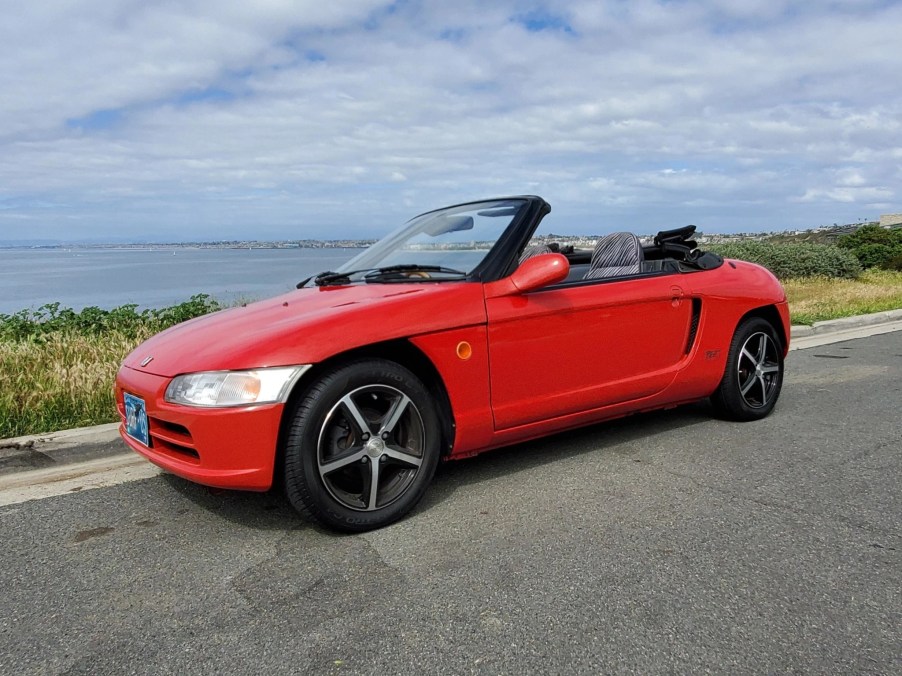
The Honda Beat Is a Mid-Engine, Pocket-Sized JDM Miata
Mazda isn’t the only Japanese automaker with an influential sports car. Honda has created its fair share as well. The S2000 competed directly with the Miata, and the NSX proved that supercars could genuinely be daily-drivable. But, as with the first Civic Type R and Nissan Skyline GT-R, some sporty JDM cars are only now becoming available in the US. Including a pint-sized, mid-engine alternative to the Miata: the Honda Beat.
What is the Honda Beat?

The Honda Beat is what’s known as a kei car, or keijidosha, CarBuzz reports. Japan introduced these compact vehicles after WWII to make its population mobile. Their size and engine capacity are limited by government regulations, to make them fit more easily in Japan’s cramped cities and roads. On the plus side, they’re cheaper to buy and insure.

Typically, kei cars take the form of sedans, hatchbacks, trucks, and vans. However, during the Bubble Era of the 80s and 90s, Japanese OEMs had enough money to get a bit experimental. Which included developing kei sports cars. One of the most extreme was the gull-winged mid-engine Autozam AZ-1. Slightly more conventional, though, was the Honda Beat, which The Drive reports was the last car Soichiro Honda personally approved.
Though the Honda Beat is mid-engine like the Toyota MR2, it’s sized more like an NA Miata. But the NA is noticeably larger, Autotrader reports. The Beat’s wheelbase is actually 1” longer, but overall, it’s 30” shorter, Automobile reports. Plus, it’s about 10” narrower.
Under the hood (trunk?) is a 656cc three-cylinder, Bring a Trailer reports, linked to a 5-speed manual. With 63 hp and 44 lb-ft, it’s not a particularly powerful engine for a car. However, it does redline at 9000 RPM. Also, the Honda Beat only weighs about 1675 pounds, making it lighter than even the Miata.
What’s the Honda Beat like to drive?

In terms of practicality, the Honda Beat falls behind the Miata. There’s no storage space in front; that’s where the fluid tanks and spare tire live. And while there is a rear trunk, it’s barely big enough for a backpack, Driving.ca reports. It’s also where the battery is stored.
However, the interior is actually roomier than you might expect. True, the hip room is fairly tight. But the cabin itself is roughly as long as the Miata’s, Autotrader reports. And if headroom is an issue, it is a convertible, after all. Plus, despite being relatively bare-bones, the Beat does offer A/C. While radio was optional, the mid-engine convertible came with zebra-print seats as standard.
In a straight line, the Honda Beat isn’t fast. 0-60 takes about 13 seconds, CarBuzz reports, and it tops out at 84 mph. But the steering is incredibly direct and communicative, and the shifter’s throws are short and very slick, Jalopnik reports. And while there is some body roll, the Beat grips well in the corners, Autotrader reports.
Getting one of your own

The Honda Beat was made from 1991-1996. Although like every other kei car, it was never sold in the US, it was popular enough to merit a successor, the Honda S660. But, thanks to the 25-rule, all but the last Beats are freely importable.
While the Honda Beat is less practical than the Miata, it’s still relatively affordable. The most expensive one sold on BaT was a 1991 example that went for $12,311. But many go for $7,000-$9,000 or even less.
This article was originally published on July 4, 2020, and was updated for freshness on June 3, 2024.


